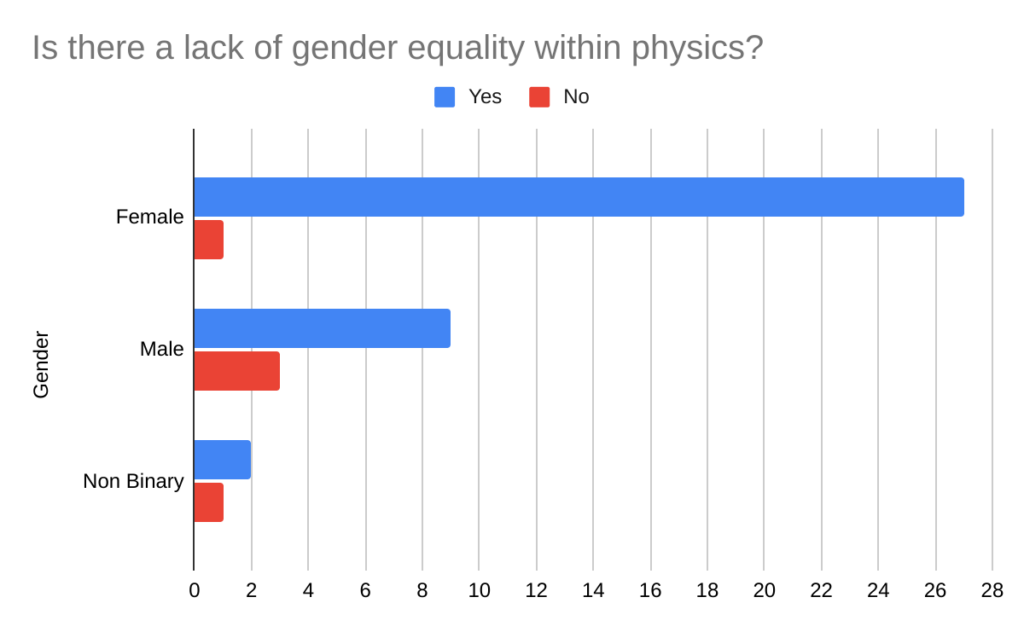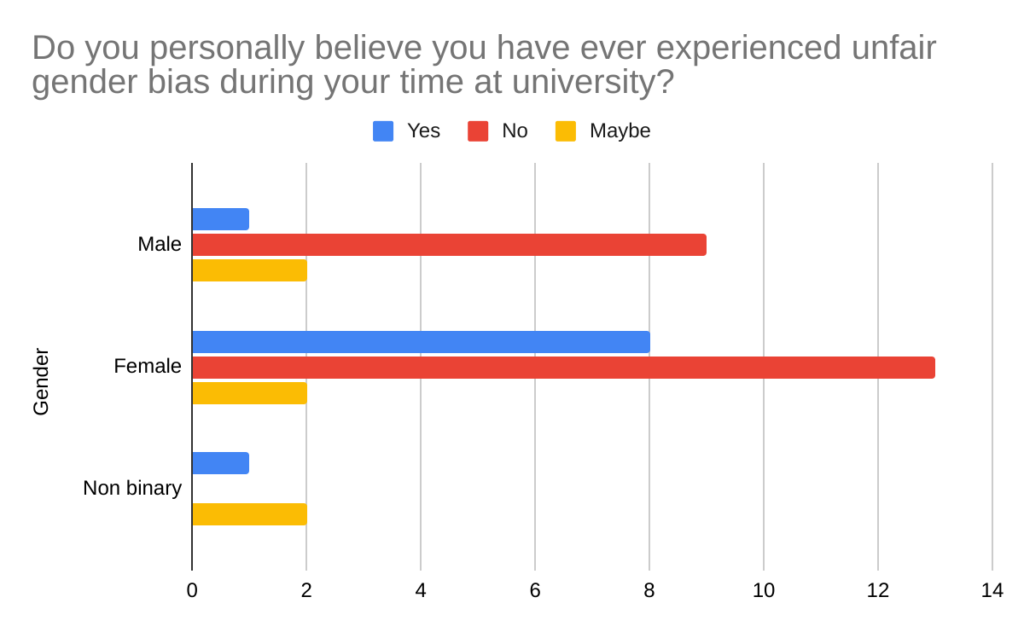by Rosie Gittings
In the world of physics, where equations dance across whiteboards and curiosity knows no bounds, a formidable force often remains – gender bias. As a physics student, I have felt the weight of condescension and an undermining of confidence, a story not too uncommon for women navigating the world of physics. It wasn’t until reading through the pages of ‘The Only Woman in the Room,’ a riveting book by Eileen Pollack, where I felt an echo of this feeling that mirrored my own experiences, when I realised this is what it is like for most women entering into a degree in physics. Fueled by my own personal experience and a desire for change, I set out to discover the untold stories within our own School of Physics at the University of St Andrews.
In early September I decided to conduct a survey (see Appendix) with the endeavour of delving into the perspectives of physics students at St Andrews on the pressing issue of gender bias and discrimination within their academic sphere. Despite efforts from the School of Physics to harbour an inclusive and diverse environment, highlighted by the prestigious Athena SWAN Silver award received in 20171, the survey results suggest a widespread gender bias in the outer world of physics. Significantly, nearly 93% of participants identifying as female or non-binary (31 of 43 participants) voiced their perception of a pronounced gender inequality within the realm of physics, while a substantial 75% of male survey participants (12 of 43 participants) shared this conviction. This figure shouldn’t come as a surprise considering a recent study at the University of Melbourne, which analysed data spanning the last 20 years, discovered that physics has one of the largest gender gaps when compared to other STEM subjects2.

But are these statistics relics of the past, with the notion that it is no longer unheard of for women to study physics? Think again. Nearly half of the participants in the survey acknowledged witnessing instances of unfair treatment towards women, stemming from both unconscious and conscious gender bias at the University of St Andrews. When delving into personal experience, only 42% of participants identifying as female or non-binary believed they had never encountered gender-based discrimination, compared to 75% of participants identifying as male.
One respondent shared a disheartening experience, stating, when she encountered a problem with her equipment, her concerns were initially met with queries about whether she had accidentally turned it off. A stark contrast to the immediate assistance offered to her male colleagues facing similar issues. This disparity not only necessitated her to repeat her request but also led to a significant loss of lab time—two hours, to be exact—forcing her to come in the next day to redo her work. This experience highlighted the challenges women face in a professional environment, struggling to achieve parity with male peers amid an undercurrent of unconscious, or perhaps even conscious, bias. It’s reassuring, however, to note that the experimental department has been made aware of these concerns, and steps are being taken to ensure that all students receive equitable support.

While I did anticipate results indicating women being condescended to by peers, I was genuinely surprised to see multiple respondents comment on instances of unfair treatment by lecturers. One participant shared how they believed “Women here tend to get patronised or overlooked in conversations and tutorials,” while another revealed witnessing a male lecturer talking down to female students. It was within the experimental department that gender equality appeared notably absent. With a few survey respondents shedding light on their perception that concerns voiced about equipment issues were not treated with the same gravity when raised by female students.
However, the main concern appears to be rooted in the interactions between male and female students. A notable challenge was seen during collaborative endeavours such as group projects and study sessions, with several participants highlighting the pervasive issue of ‘mansplaining’. Cambridge Dictionary states that mansplaining refers to “the act of explaining something to someone in a way that suggests that they are stupid; used especially when a man explains something to a woman she already understands”3.
A recurring theme throughout the survey discloses instances where women are excluded from discussions, talked over, and have their ideas dismissed until validated by a male peer. Shockingly, the accounts go beyond mere exclusion, revealing more insidious remarks, in one instance including inappropriate comments about something a woman was wearing.
As I began my journey in physics, I struggled with the notion that embracing my feminine interests might undermine my professional credibility. This feeling was mirrored by another respondent who experienced a sense of shame for having interests deemed ‘girly’, as these were seen as incompatible with the field of physics.
While these comments may seem innocuous, research indicates that the cumulative impact of microaggressions can be corrosive, leading to diminished self-worth, reduced participation, and an inhibited ability to thrive in such an environment4.
Before delving further, it’s essential to address the issue of selection bias. In any group, there will be individuals both satisfied and dissatisfied with various matters. When it comes to surveys, those with negative experiences are more likely to voice their opinions. Although it is disheartening to witness the persistence of gender bias struggles in our community, and action should be taken to prevent future occurrences, the limited positive responses may be influenced by selection bias in the data.
With that taken into account, the survey does suggest a silver lining – female and non-binary students at the University of St Andrews who participated expressed a higher inclination in pursuing physics-based careers after graduation compared to the national average. However, this optimism is lessened by the reality that gender-based discrimination persists, even in job application processes. A study conducted by Moss-Racusin and her team revealed disturbing biases in hiring practices. Identical CVs for a lab manager job, under the names ‘Jennifer’ and ‘John’ were shown to a group of professors, ‘Jennifer’ consistently received lower ratings for competence and hireability. Additionally, the professors taking part in the study were far less willing to provide mentorship to ‘Jennifer’, despite identical qualifications with ‘John’5.
On a more positive note, St Andrews University stands out in advancing gender inclusion in various aspects. Approximately 40% of physics students identify as female, surpassing the average of 24% observed at other universities6. This noteworthy achievement is further enhanced by the university’s dedication to fostering important discussions about unconscious bias in the Transferable Skills module.
Additionally, the impactful research undertaken within the physics department has culminated in the development of an invaluable Impostor Syndrome workshop, now an integral part of the first-year curriculum. This initiative reflects the university’s proactive approach in addressing psychological barriers and promoting a more inclusive and supportive academic environment. These initiatives highlight our university’s dedication to leading the way in eradicating gender bias within the field of physics.
But why does all of this matter? The significance lies in paving the way for equal opportunities in which women can thrive. The shortage of women in the STEM workforce hinders intellectual progress, which depends on attracting the very brightest minds – regardless of gender.
There’s no quick fix to addressing systemic issues ingrained in institutional foundations; solutions tend to be gradual and incremental. Most respondents focused on one key solution—increasing the representation of female role models within physics. One participant succinctly captured this, stating, “There is a culture behind certain subjects like physics, maths, computer science, which are portrayed as ‘unfeminine.’ We need to take action in removing these cultural stigmas by not characterising certain subjects as more masculine or feminine. If it’s cool and fun to learn, it’s cool and fun to learn!”. Showcasing more female physicists as role models proves that physics isn’t inherently masculine. Another recurring solution emphasises hosting more female-centric groups in physics with the aim of encouraging a supportive community, acknowledging the importance of solidarity in overcoming gender biases.
The journey to gender equality in physics is an ongoing process, marked by significant progress. Reflecting on experiences detailed in “The Only Woman in the Room”, which recounts challenges faced by women studying physics in the 1970s, we recognise the substantial distance we’ve covered since then. While acknowledging these strides taken, it is crucial to shed light on the remaining challenges. In doing so, we contribute to paving the way for a cosmos where every aspiring physicist can thrive, regardless of gender.
If any of the topics discussed have resonated with you or if you have suggestions for improvements within the school, we encourage you to reach out to [email protected]. For issues of harassment or violence, you can contact the Report+Support team (https://reportandsupport.st-andrews.ac.uk/) which allows incidents of abuse to be reported anonymously. Your input is valuable in shaping a more inclusive and progressive educational environment.
References
- www.st-andrews.ac.uk. (n.d.). Equality, diversity and inclusion – School of Physics and Astronomy – University of St Andrews. [online] Available at: https://www.st-andrews.ac.uk/physics-astronomy/about/equality-diversity-inclusion/ [Accessed 28 Oct. 2023]. ↩︎
- Physics World. (2018). Gender gap in physics among highest in science. [online]
Available at:
https://physicsworld.com/a/gender-gap-in-physics-amongst-highest-in-science/#:~:text=Phys
ics%20has%20one%20of%20the [Accessed 28 Oct. 2023] ↩︎ - dictionary.cambridge.org. (n.d.). mansplaining. [online] Available at: https://dictionary.cambridge.org/dictionary/english/mansplaining. ↩︎
- The University of Edinburgh. (n.d.). Effects of Microaggressions. [online] Available at: https://www.ed.ac.uk/equality-diversity/students/microaggressions/effects-of-microaggressions [Accessed 28 Oct 2023]. ↩︎
- Harvard.edu. (2022). Science Faculty’s Subtle Gender Biases Favor Male Students | Gender Action Portal. [online] Available at: https://gap.hks.harvard.edu/science-faculty%E2%80%99s-subtle-gender-biases-favor-male-students [Accessed 28 Oct 2023]. ↩︎
- Students in UK physics departments. (n.d.). Available at: https://www.iop.org/sites/default/files/2020-07/Student-characteristics-2017-18.pdf [Accessed 28 Oct 2023]. ↩︎
Appendix


